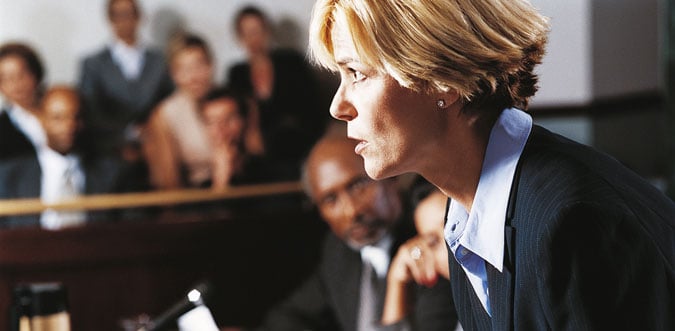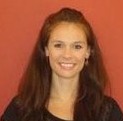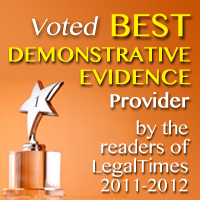Trial Technology - A Core A2L Consulting Service

In the 1950s, lawyers used blackboards and chalk to create instant visuals as they presented cases. Precariously balanced on easels, flip charts soon followed. Videotape players, slide projectors, and overheads made their appearance and larger exhibits were possible when the technology for printing full-color enlargements developed later in the 1970s. Video presentations from bar code controlled laser disks on larger television monitors emerged in the 1980s. These displays assisted witnesses with testimony and aided in jury understanding. Later in the 1980s, more sophisticated laser disks appeared and in the 1990s, CD players offered even more versatility. Evidence cameras were seen at high-profile trials and telestrator units allowed lawyers to “draw” on computer screens as they presented their positions. By the mid-1990s, laptop computers began to replace cumbersome equipment.
Trial Technology in the Modern Courtroom
Modern trial technology puts evidence before everyone in the courtroom at the same time. It conveys many kinds of information efficiently from many formats and provides effective tools for lawyers to draw participant attention to particular facts and emphasize important aspects of the evidence. It creates images for what once existed only in memories formed by the spoken word. Lawyers now use visuals to enhance memory and refer to them when the retrieval memories is crucial for persuasion. While lawyers are accustomed to handling documents, they often fail to appreciate that lay people may not have much experience with the task. Most jurors can observe displays while following a lawyer’s explanation much easier than if they had to find their place in a hard copy, and try to read it while listening to a lawyer's explanation at the same time.
An attorney’s use of modern trial technology often includes communications tasks and the presentation of evidence.
Communications
Audio systems are the foundation of trial technology; however, when combined with additional technologies such as audio conferencing, videoconferencing, translation, and assistive listening devices, things get slightly more complicated. Well designed systems include a control system with microphones, audio processors, and amplifiers. If videoconferencing is used, audio systems incorporate an echo-cancellation system.
Assistive Listening Devices
These devices assist individuals with hearing loss and are also used to benefit court reporters. Foreign language interpretation technology can use the same system and many have multiple frequencies, allowing the same system to be used for different languages at the same time.
Remote Appearance Systems
Videoconferencing allows individuals and groups in different locations to communicate efficiently. Recent cost reductions have made this type of communication common. Quality has increased significantly, with reduced or complete elimination of time delays.
Evidence Presentation Systems
Many attorneys believe evidence presentation is the most important use of trial technology. Judges use the technology to display instructions for juries and it provides attorneys with courtroom display options, annotation devices, and video printers. Please see our articles related to trial technology and Trial Director.
Courtroom Display Options
Lawyers display evidence to judges and juries on large projection screens and monitors. Some prefer a single large screen for focusing the attention of participants on one location. Others prefer small monitors placed throughout the courtroom to decentralize presentations and make viewing easier for larger audiences. Other determining factors for courtroom displays include courtroom design and layout, lighting, and the type of evidence being presented.
The major disadvantage of television monitors is low screen resolution. High resolution monitors and projection screens are now the preferred choice for image quality and they also offer the flexibility of using different size monitors based on their location in the courtroom.
Annotation Devices
Annotation devices allow participants to mark images being displayed through video evidence presentations. A “John Madden” style light pen is used by many attorneys. Witnesses can utilize the pen to draw directly a monitor and the image can be viewed simultaneously on additional monitors in the courtroom. Writing tablets work in a similar way, but annotations cannot be made directly on the monitor. Touch screens are also used for the same effect.
Video Printers
Evidence presentation creates electronic images that may not be permanent, unless stored. If another image is displayed or power is lost to the equipment, the evidence and any annotations may be lost. Video printers store images of video being displayed on courtroom monitors and attorneys use them to preserve information for appellate records and jury deliberations. This method also preserves annotated materials. Printers are mounted on a podium or an equipment cart, or near the desk of the court reporter.
Trial Technology Effectively Changes Courtroom Dynamics
At A2L consulting, we've used trial technology effectively for litigators from all major U.S. law firms and most of the largest international firms.
About A2L Consulting's Trial Technology Consultants:
We are available and routintely work worldwide. Our trials, hearings and other events most often take us to New York, Los Angeles, Chicago, Dallas, Philadelphia, Camden, Wilmington, Houston, Washington DC, Arlington, Alexandria, Miami, Atlanta, Boston, San Francisco, Phoenix, Seattle, Minneapolis, San Diego, St. Louis, Baltimore, Denver, Pittsburgh, San Antonio, Orlando, Kansas City, Las Vegas, San Jose, Columbus, Charlotte, Indianapolis, Austin, Norfolk, Providence, Jacksonville, Memphis, Richmond, Oklahoma City, New Orleans and Salt Lake City.
Have Questions or Need Help?
Contact Persuadius 24/7 to run I would be happy to serve as your point of contact for questions about jury consulting, mock trials, litigation graphics, in-court trial support technicians, visual advocacy and other litigation consulting services: Michele Hargrove
Michele Hargrove
Director, Client Development
800.847.9330
hargrove@persuadius.com




